Lemon is a species of the genus Citrus, cultivated on an industrial scale in regions with a subtropical climate. In nature, the lemon tree reaches a height of 8 m, while the indoor representative of the species is represented by low-growing plants, whose branches are covered with thorns. Lemon in a pot is appreciated not only for its fruits - during the period of prolonged flowering (about 2 months) beautiful flowers bloom, captivating with its marvelous aroma.
Material Content:
Lemon Tree Varieties for Home Growing
As a result of the continuous work of breeders, many varieties were bred, both for agriculture and indoor floriculture. There are varieties that can bear fruit all year round, as well as exclusively decorative. There are short and tall forms.

Among the most popular varieties adapted to housing conditions, stand out:
- "Meyer's Lemon" is an early ripening variety with two or three times flowering throughout the year. A plant with a height of up to 1.5 m produces fruits weighing up to 150 g with slightly acidic pulp.
- Pavlovsky is the result of domestic selection, therefore the variety is well adapted to home cultivation and is most common among flower growers.
- "Lisbon" - the variety is characterized by good adaptability to the housing environment, which gives it the opportunity to cope with dry air. A fast-growing plant up to 2 m tall produces fruits weighing 150 g.
- "Genoa" is a fruitful variety of Italian breeding, which is able to bear fruit several times a year. The maximum height of the tree does not exceed 1.5 m.
- “Kurskiy” is a domestic variety distinguished by drought tolerance, shade tolerance, and rather high yields. The average weight of the fruit is 120 g.
- “Kiev large-fruited” is a low-growing variety with fruits up to 1.5 kg, which can be harvested every season, provided that it is properly maintained, including systematic pruning.
Optimal conditions for breeding lemon
The easiest way to grow a lemon tree is from a stone.
To do this, it is enough to purchase a ripe fruit in the store without visible damage with mature seeds.
Correct soil composition
Lemon tree needs a light, permeable substrate with a slightly acidic reaction (pH 6.6-7.0), which is easy to prepare by mixing peat and universal soil for flowers in equal quantities.
What is better to grow a lemon tree
When choosing a pot for a lemon tree in the initial stages (planting and 2 subsequent transplants), you can stop on plastic. However, due to its disadvantages, which are lightness and water resistance, preference should be given to wooden tubs.
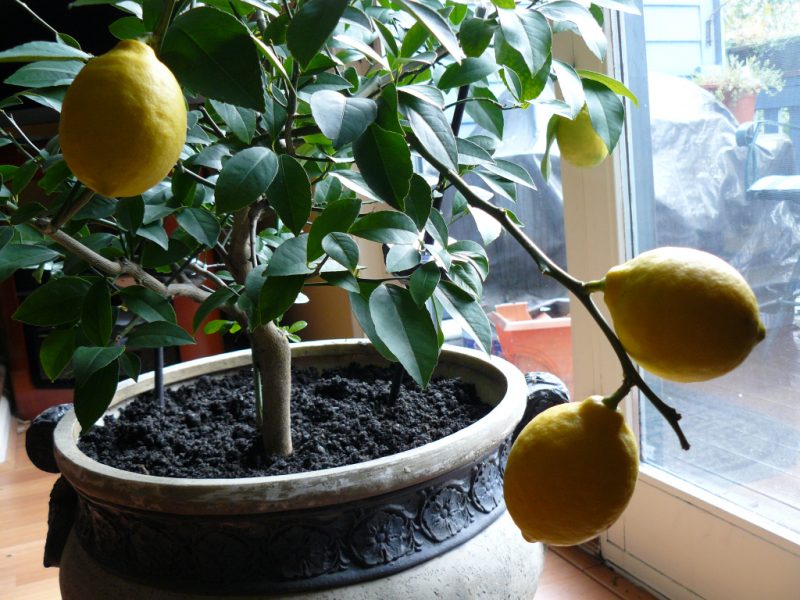
Despite the fragility, wooden dishes have all the necessary qualities for growing lemon:
- water permeability;
- ease of disinfection;
- sustainability.
Before filling the selected container with a substrate, it is necessary to place a drainage layer of expanded clay, crushed stone or gravel at the bottom.
Attention! The diameter of each new tank should not exceed the same parameter of the previous pot by more than 6 cm. Soil not occupied by roots has the property of souring.
How to choose a plant location
Lemon is a plant of short daylight hours, which makes it possible for it to tolerate deficiency of lighting normally. In the case of a long daylight hours, the tree will grow more actively, but the fruiting phase will come later. The optimal place in the house will be the window sill of the east or south window with easy shading after dinner. In winter, when cloudy weather prevails, an artificial light source is installed, working about 6 hours a day.
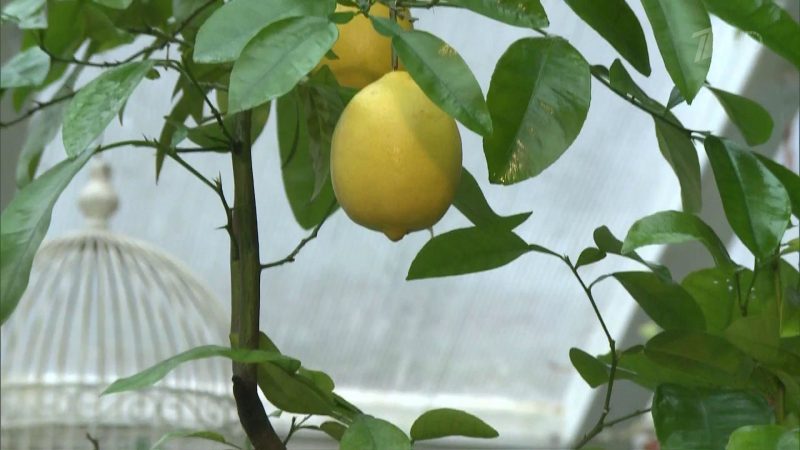
Advice! In order for the plant to develop equally on all sides, you should turn the pot clockwise 10 ° once every 10 days.
Lemon Tree: Home Care
Care for the lemon tree should be permanent and include a number of important activities, without which fruiting, indicating the health and strength of the plant, is simply impossible.
Watering and humidity
The inhabitant of the subtropics from late spring to early autumn needs daily watering, which should be carried out with purified water at room temperature.

In other periods, it is enough to moisten the lemon twice a week so that the substrate has time to slightly dry. Exotic plants, despite being adapted to low humidity, require daily spraying, which can only be stopped when the tree is in the cool of winter.
Temperature
To build green mass, it is enough for a lemon tree to provide a temperature regime within 17 ° C.
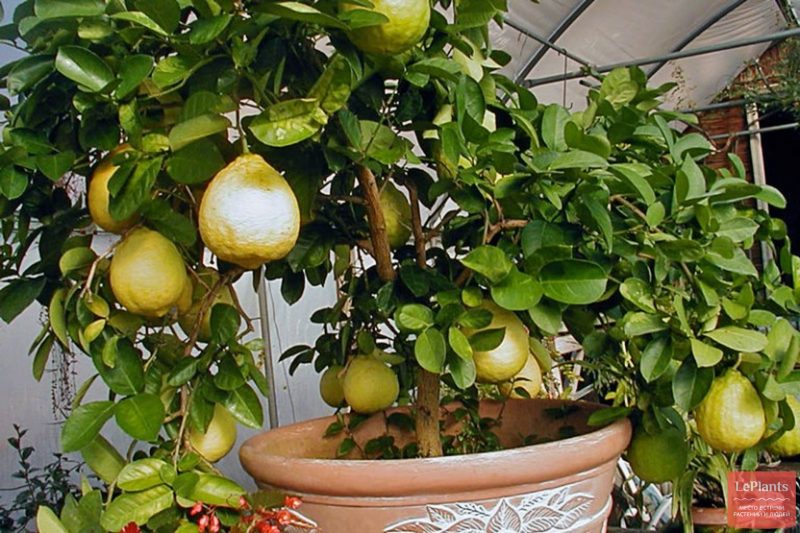
- During the formation of buds and ovaries, the mercury column should not rise above the 18 ° C mark, otherwise this could threaten the discharge of future fruits.
- But when citrus fruits ripen, the temperature rises to 22 ° C and higher.
- With the advent of winter, if possible, it is worthwhile to arrange for the lemon tree a dormant stage at a temperature of 12-14 ° C so that the plant stores energy before the upcoming season.
Fertilizer and fertilizer
To preserve vitality, lemon needs regular top dressing, which is carried out for young plants every 6 weeks, and for adults every 3 weeks with the help of complex mineral fertilizers. In winter, the interval between top dressing increases. If the plant is in a dormant state, then it completely stops.

Caution! An excess of nitrogen fertilizers can stop the onset of the fruiting phase due to the active growth of green mass.
How to prune a lemon tree
For a decorative lemon, the crown is formed compact, small in size.
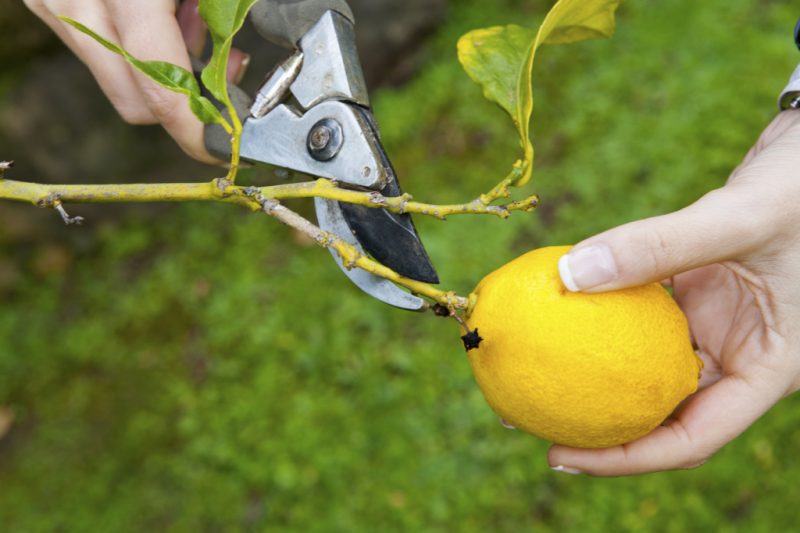
If the goal is to obtain fruits, then the formation is carried out according to the following scheme:
- When the seedling reaches a height of 25 cm, a pinch is carried out.
- After the stem grows another 20 cm, it is pinched a second time so that 4 growth buds remain between the pinches, from which the skeletal branches will develop.
- First-order shoots are nipped at intervals of 25 cm, and after they mature, they are shortened by 5 cm below the pinch.
- Each subsequent branch should be 5 cm shorter than the previous one.
- Trimming the fourth order of shoots completes the formation.
In addition to the forming haircut, sanitary pruning is carried out if necessary: weak, injured, shoots growing inward are removed.
Plant transplant technology
A lemon transplant is carried out before the volume of the pot reaches 10 liters. Then only the top layer of the substrate is updated.

A plant is transplanted according to this scheme:
- A pot of the required volume is prepared, on the bottom of which a drainage layer is placed.
- A plant with an earthen lump is being transshipped from an old tank.
- The remaining space is covered with a light substrate for lemon.
Pest and Disease Control
Due to the moisture-loving nature of the culture, fungal diseases such as powdery mildew and gray rot often develop on it, the best protection against which is the observance of agricultural technical care requirements.

Among the pests on lemon shoots, damage to the spider mite, whitefly, scale insects, mealybug and aphids are noted. When identifying harmful insects, it is worth resorting to insecticide treatment, since alternative methods are far from always effective, especially with strong population.
What difficulties can you encounter when growing
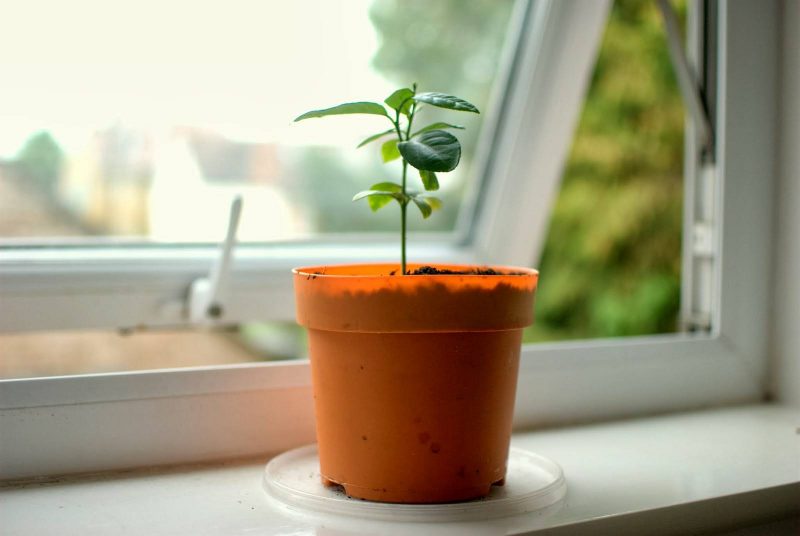
Growing a lemon tree often raises many questions, for the solution of which it is necessary to establish a reason:
- Yellowing lemon. The problem arises for a number of reasons - with a low level of humidity, nutritional deficiency, high temperature in the winter, or because the plant is populated by a spider mite.
- Fall of foliage, ovary. If you encounter such a difficulty, you should pay attention to the level of moisture in the soil and air. Typically, this is due to moisture deficiency.
- Curl leaves. If leaf plates began to dry and curl on a lemon, this is due to a violation of the general maintenance requirements. A review of ongoing activities will identify the cause.
So, despite the fact that growing lemon is a rather troublesome task, the result is worth it: high decorativeness, wonderful aroma during flowering and healthy fruits rich in vitamins will certainly inspire the florist to make new experiments.












